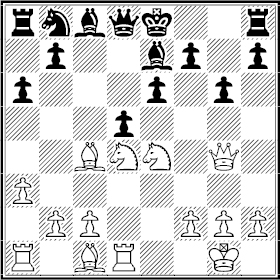
When everything looks bleak, the defender’s best weapon is surprise.
Alexander Beliavsky White
Alvis Vitolinsh Black
Soviet Championship 1972
Sicilian Defense, Najdorf Variation B86
1 e4 c5 2 ♘f3 d6 3 d4 cxd4 4 ♘xd4 ♘f6 5 ♘c3 a6 6 ♗c4 e6 7 0-0 ♗e7 8 a3
White wants to retreat his bishop to a2 and take the sting out of ...b5-b4.
8...♘xe4? 9 ♘xe4 d5
The fork trick would equalize after 10 ♗d3 dxe4 11 ♗xe4 ♘d7.
10 ♕g4!
But this makes it hard for Black to regain his piece, e.g. 10...dxc4? 11 ♕xg7. Or 10...dxe4 11 ♖d1, threatening 12 ♘xe6.
10...g6 11 ♖d1
Now 11...dxe4 12 ♘xe6!. Or 11...dxc4 12 ♘f5! with threats of ♖xd8+ and ♘fd6+.

11...♕c7
The best try is 11...f5!?!, a shock move that succeeds after 12 ♕e2? fxe4. Instead, White would have to calculate head-spinning lines such as 12 ♘xf5. He would have to work to find a win after, say, 12...exf5 13 ♕f4.
12 ♗g5 dxe4?
The surprise 12...f5! would still leave the outcome in doubt.
13 ♗xe7 f5 14 ♗d8 resigns.
Black saw 14...fxg4 16 ♗xc7 or 14...♕xd8 15 ♘xf5!.
Question 391: What were the last two mistakes of the game?
Another example of a failed fork trick:
Vitaly Tseshkovsky White
Anatoly Lutikov Black
Almaty 1968
1 e4 e5 2 ♘f3 d6 3 d4 ♘f6 4 ♘c3 ♘bd7 5 ♗c4 ♗e7 6 0-0 0-0 7 a4 c6 8 ♕e2 exd4 9 ♘xd4 ♘xe4? 10 ♘xe4 d5 11 ♘f5! dxc4 12 ♗h6! ♘f6 (12…gxh6 13 ♕g4+ ♗g5 14 ♘xh6+ ♔g7 15 ♘f5+) 13 ♘eg3 ♗xf5 14 ♘xf5 gxh6 15 ♘xe7+ ♔g7 16 ♘f5+ ♔g6 17 ♘e7+ ♔g7 18 ♕e5 ♕b8 19 ♘f5+ ♔g6 20 ♘d6 ♔g7 21 ♖fe1 ♖d8 22 ♖ad1 ♖d7 23 ♖d4 ♕c7 24 ♖g4+ resigns.